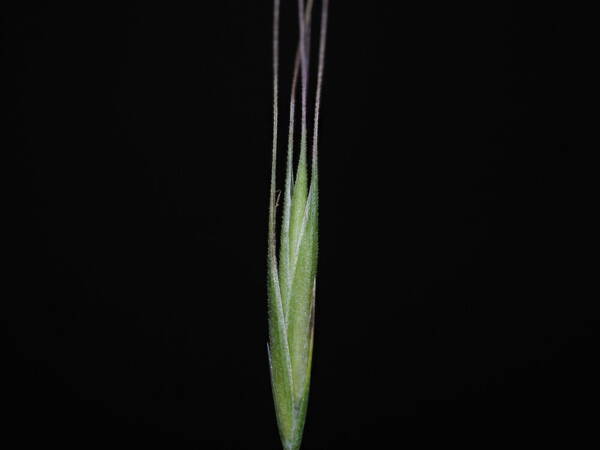Info
Subfamily: Pooideae
Genus etymology: Festuca = "stem / straw" [Latin]
Species etymology: bromoides = "resembling the genus Bromus L." [Latin] refering to the inflorescence
Photosynthetic type: C3 (cool season)
Nativity: naturalized - accidental
First recorded in Hawaiʻi: 1902
Map


Inflorescence


Plant

Spikelets








Description
Annual. Culms 5–60 cm. high, loosely tufted or solitary, erect or geniculately ascending, slender. Leaf-blades 1–18 cm. long and 0.5–3 mm. wide, flat or rolled, rough near the tip and on the margins, puberulous above. Panicle lanceolate to narrowly oblong, 1–13 cm. long, loose or contracted, erect or nodding, long-exserted from the sheath. Spikelets oblong or wedge-shaped, 7–14 mm. long (excluding awns), 3–10-flowered, green or purplish; lower glume linear-lanceolate, 2–6 mm. long; upper glume subulate-lanceolate, 5–10 mm. long; lemmas 6–9 mm. long, scabrid, tipped with a scaberulous awn up to 12 mm. long; anther usually 1, 0.3–0.6 mm. long. Fig. 22.
(Description source: Clayton, W.D. 1970. Flora of Tropical East Africa. Gramineae (Part 1). Crown Agents for Oversea Governments and Administrations, London. 176 pp. )
Culms 5-50 cm, solitary or loosely tufted, erect or decumbent, smooth, scabridulous, or puberulent, unbranched distally. Sheaths glabrous or puberulent; ligules to 0.5(1) mm; blades usually 2-10 cm long, 0.5-2.5 mm wide, rolled or flat, glabrous or puberulent. Panicles 1.5-15 cm long, 0.5-3 cm wide, conspicuously exserted, with 1 branch per node; branches usually appressed to erect at maturity, without axillary pulvini; pedicels flattened, sometimes clavate distally. Spikelets 5-10 mm, with 4-8 florets, not closely imbricate; rachilla internodes 0.6-1.1 mm. Lower glumes 3.5-5 mm, 1/2 - 4/5 the length of the upper glumes; upper glumes 4.5-9.5 mm, midveins scabrous distally; lemmas 4-8 mm, 5-veined, scabrous distally, apices entire, awns of the lowermost lemma in each spikelet 2-13 mm; paleas 4-6.3 mm, equaling or shorter than the lemmas, minutely bifid; anthers 0.4-0.6(1.5) mm. Caryopses 3.5-5 mm. 2n = 14.
(Description source: Barkworth, M.E., Capels, K.M. & Long, S. (eds.) 1993. Flora of North America, north of Mexico. Volume 24. Magnoliophyta: Commelinidae (in part): Poaceae, Part 1. Oxford University Press, New York. 911 pp. http://floranorthamerica.org/Festuca_bromoides )
Glabrous annuals; culms loosely tufted, base decumbent, 1-3(-5.5) dm tall, lower nodes geniculate. Sheaths open, sparsely to evenly pilose or glabrous, margins membranous, overlapping; ligule erose-ciliate, 0.2- 0.6 mm long; blades usually involute, filiform, lower surface pubescent. Panicles often slightly secund, narrow, 2-8(-12) cm long, with short, ascending branches, sometimes the lower branches spreading; spikelets 3-5(-6)-flowered; glumes unequal, first glume 3.5-5(-7) mm long, filiform, 1-nerved, second glume lanceolate, 4.5-8 mm long, prominently 3-nerved, sometimes slightly awn-tipped; lemmas (4-) 5.5-7.5 mm long, minutely scaberulous or glabrous, the awns (4-)6-11(-15) mm long; palea narrow, apex bifid. Caryopsis 3.5-4 mm long. [2n = 14.]
(Description source: O’Connor, P.J. 1990. Poaceae, pp. 1481–1604. In: Wagner W.L., Herbst D.R. & Sohmer S.H. (eds.)., Manual of the flowering plant of Hawaiʻi. Vol. 2. University of Hawaii Press & Bishop Museum Press, Honolulu )